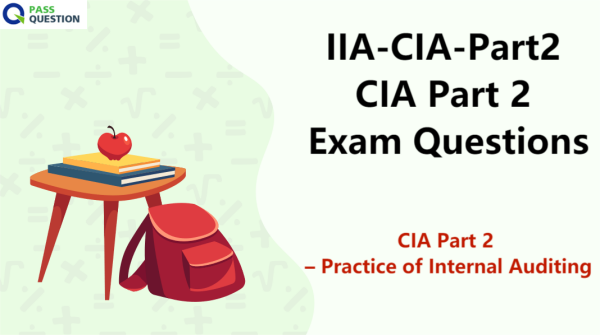IIA-CIA-Part2 CIA Part 2 Exam Questions - Part 2 – Practice of Internal Auditing
Passing the IIA-CIA-Part2 exam is not an easy task, and it requires thorough preparation and practice. That's why PassQuestion provides the latest IIA-CIA-Part2 CIA Part 2 Exam Questions to help candidates pass the exam easily. The IIA-CIA-Part2 practice test questions cover all the topics and domains of the exam, and they are designed to simulate the real exam environment. PassQuestion updates its IIA-CIA-Part2 CIA Part 2 Exam Questions regularly to ensure they align with the latest exam objectives and internal audit practices. Candidates can be confident that they are practicing with the most up-to-date and accurate questions. With PassQuestion's help, candidates can be confident in their ability to pass the IIA-CIA-Part2 exam and further their career as internal auditors.

What is tested on CIA exam Part 2?
CIA Part 2 covers management of the internal audit function and individual engagements, as well as fraud risks and controls The CIA exam Part 2 includes four domains focused on managing the internal audit activity, planning the engagement, performing the engagement, and communicating engagement results and monitoring progress. Part 2 tests candidates' knowledge, skills, and abilities particularly related to Performance Standards (series 2000, 2200, 2300, 2400, 2500, and 2600) and current internal audit practices.
Practice Online Free CIA Part 2 IIA-CIA-Part2 Practice Exam Questions
Part 2 – Practice of Internal Auditing Exam Domains
I. MANAGING THE INTERNAL AUDIT ACTIVITY (20%)
II. PLANNING THE ENGAGEMENT (20%)
III. PERFORMING THE ENGAGEMENT (40%)
IV. COMMUNICATING ENGAGEMENT RESULTS AND MONITORING PROGRESS (20%)
View Online CIA Exam Part Two: Practice of Internal Auditing IIA-CIA-Part2 Free Questions
1.An internal auditor accessed accounts payable records and extracted data related to fuel purchased tor the organization's vehicles As a first step, she sorted the data by vehicle and used spreadsheet functions to identify all instances of refueling on the same or sequential dates She then performed other tests.
Based on the auditor's actions which of the following is most likely the objective of this engagement1?
A. To identify whether fuel was purchased for work-related purposes
B. To estimate future fuel costs for the organization's fleet of vehicles
C. To determine trends in average fuel consumption by vehicle
D. To determine whether the organization is paying more than the industry average for fuel
Answer: C
2.An internal auditor tested whether purchase orders were supported by appropriately approved purchase requisitions She sampled a population of purchase documents and identified instances where purchase requisitions were missing However, she did not notice that n some cases purchase requisitions were approved by an unauthorized person.
Which of the following risks most appropriately describes this situation?
A. Nonsampling risk
B. Sampling risk
C. Inherent risk
D. Due diligence risk
Answer: A
3.An internal auditor submitted a report containing recommendations for management to enhance internal controls related to investments.
To follow up, which of the following is the most appropriate action for the internal auditor to take?
A. Observe corrective measures.
B. Seek a management assurance declaration.
C. Follow up during the next scheduled audit.
D. Conduct appropriate testing to verify management responses.
Answer: D
4.A chief audit executive (CAE) reviews the supervision of an internal audit engagement.
Which of the following would most likely assure the CAE that the engagement had adequate supervision?
A. The engagement supervisor has an open door pokey for audit team members to discuss concerns
B. The supervisor reviews weekly progress reports from the audit team members
C. The supervisor reviews and initials internal audit workpapers for the engagement
D. The supervisor meets periodically with management in the reviewed area to get feedback during the engagement.
Answer: C
5.A corporate merger decision prompts the cruel audit executive (CAE) to propose interim changes lo the existing annual audit plan to account for emerging risks.
When of the following is the most appropriate action for the CAE to take regarding the changes made to the audit plan?
A. Present the revised audit plan directly to the board for approval
B. Communicate with the chief financial officer and present the revised audit plan to the CEO for approval
C. Present the revised audit plan directly to the CEO for approval
D. Communicate with the CCO and present the revised audit plan to the board for approval
Answer: D
6.Which of the following statements regarding the risk management process' support of the internal audit activity is true?
A. The risk management process can provide more extensive internal audit services to the organization if it does not have an internal audit department
B. The risk management process supports internal audit by evaluating whether critical controls are adequate and effective.
C. The risk management process can determine whether all significant risks have been identified and are being treated.
D. The risk management process establishes an organization-specific documented risk management framework.
Answer: A
- TOP 50 Exam Questions
-
Exam
All copyrights reserved 2025 PassQuestion NETWORK CO.,LIMITED. All Rights Reserved.

